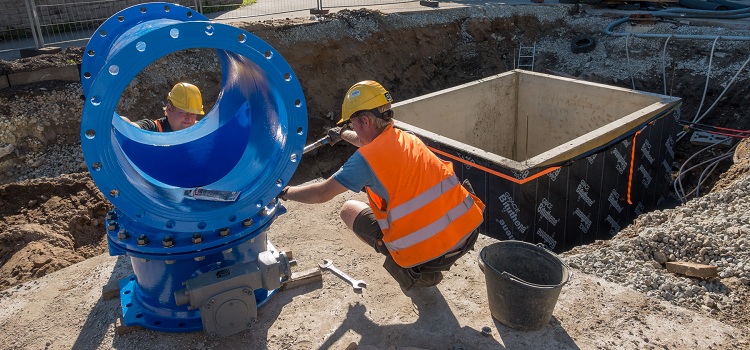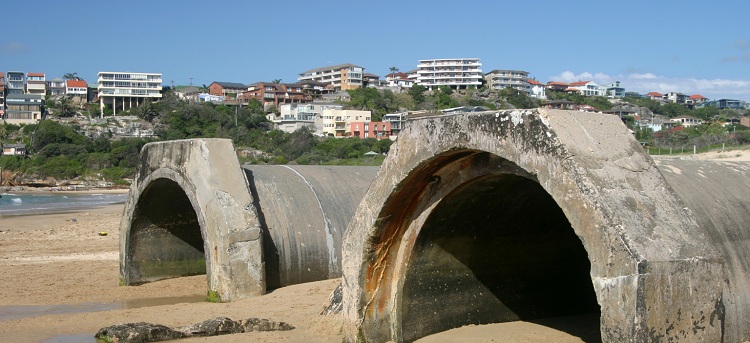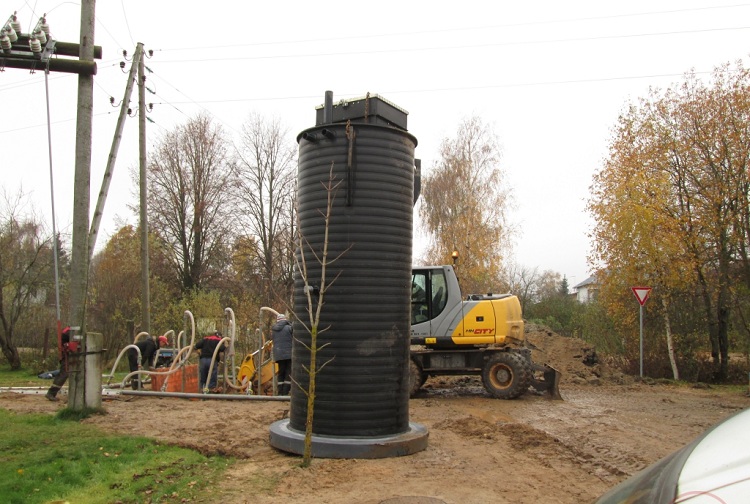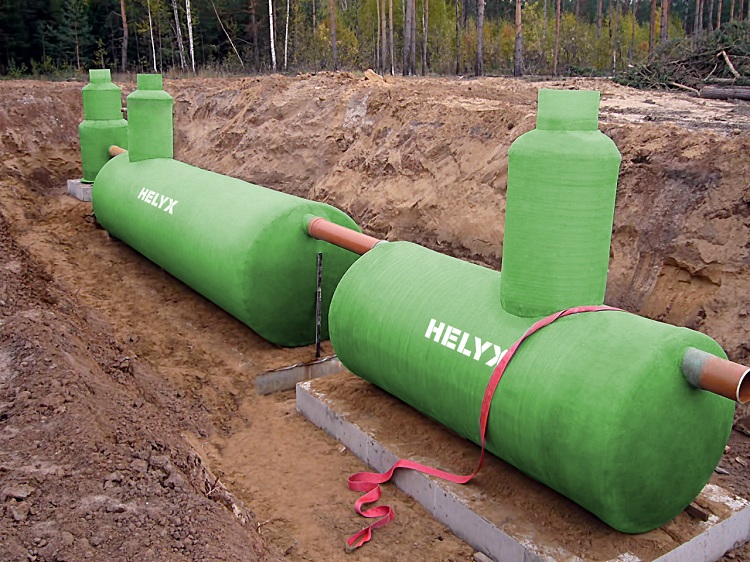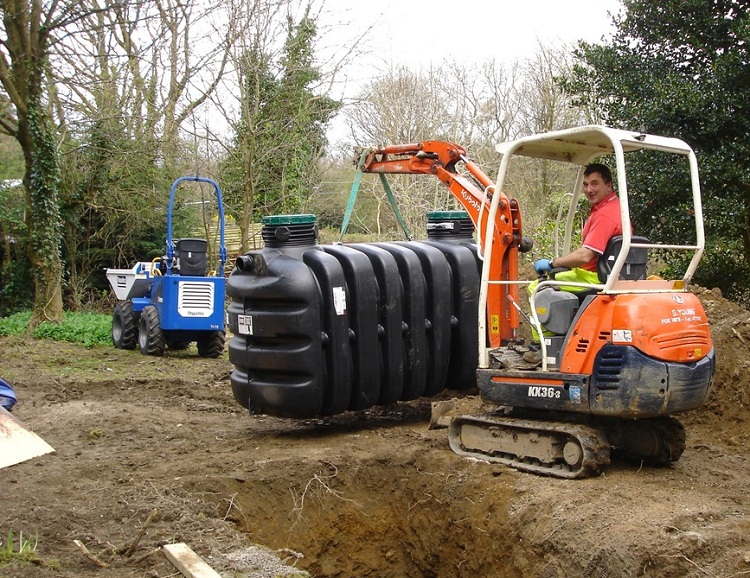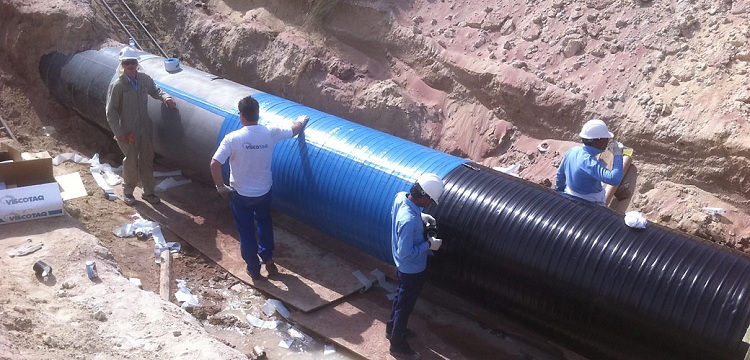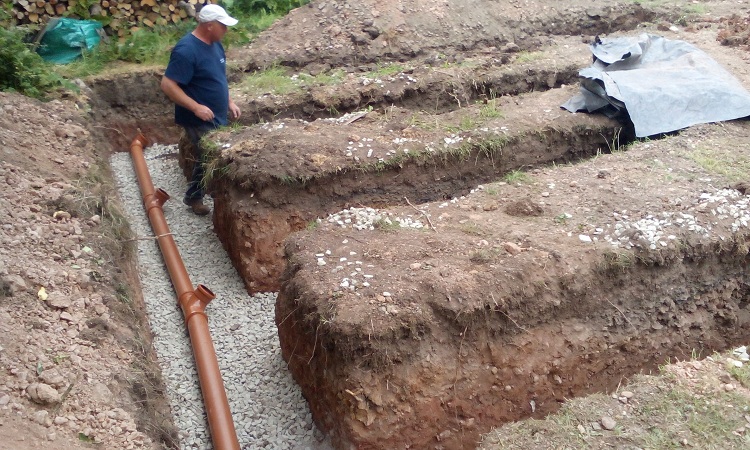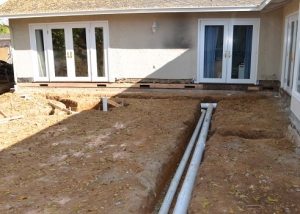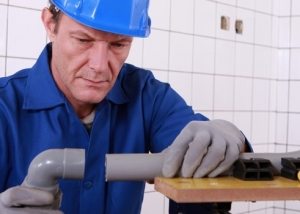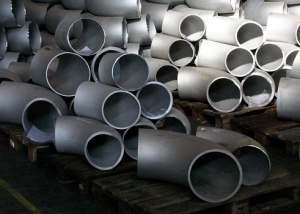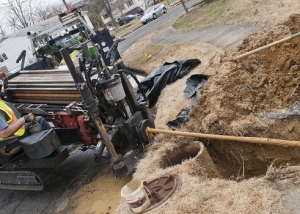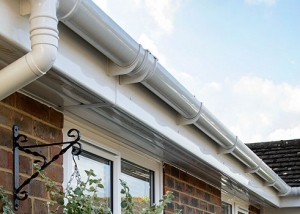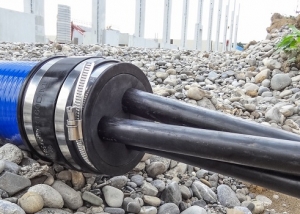External sewage networks, their installation and operation are regulated by building codes and rules (SNiP). Such communications are arranged in multi-storey, private houses, industrial and public facilities. Installation of such a system allows for convenient drainage of sewage from residential buildings. To lay such a network, it is necessary to pay attention to the basic installation rules and technical characteristics of the pipes used for this.
Content
Types of sewer networks
Sewer network is a branched communication, mounted from separate pipes into a single whole. Such a system transports wastewater from consumers to special containers that process and purify water. Sewerage network can be of two types:
- Outdoor.
- Inner.
The appearance includes pipes and sewage treatment plants located on the street, and the interior includes indoor structures.
Drains in such communications can be transported under pressure or by gravity. Based on this, all sewer pipelines can be divided into:
- pressure head;
- pressureless.
Note! Non-pressure pipelines of water supply and sewage systems are usually installed at a certain slope to ensure the natural movement of wastewater to the final destination. A popular material for arranging pressure-free sewage is polyethylene (PE).
Pressure networks operate on this principle: the pump pumps up the necessary pressure, under the influence of which, sewage is discharged. Pipes for pressure pipelines must be of good strength to cope with pressure (e.g. PVC).
In addition, all sewer systems are divided into types, depending on the purpose:
- household;
- production;
- storm (discharging rain and melt water).
Household sewer communication, in turn, is of two types:
- central (main);
- autonomous (local).
The central type carries out sewage from all houses in a small village or area of the city, and the autonomous construction serves the maintenance of one house or, in some cases, several.
According to the installation method, external sewer systems are usually divided into:
- alloy;
- semi-separate;
- separate.
In general alloy sewage, all water (household, melt, rain) is discharged together along the same path. In semi-separate communications, the discharge of household effluents and melt water takes place separately, however, their final destination is common. Separate systems involve the removal of wastewater and other waters - separately from each other in different tanks.
External sewer networks
There are several types of sewage systems laid by the external method.
Trace This design is mounted from the starting point to a special assembly tank. Tracing can be installed even in an apartment building (subject to all building codes and rules). Pipe laying is carried out only in a vertical plane. It should be noted that there must be a distance of at least 3 m from the external wall of the building to such communication. Installation of the trace can be carried out only when it is possible to connect to the central sewer network.
Street sewer network. Such a system is represented by a complex system of pipes and wells. The laying of such communication is carried out on all streets of the city. Through the street sewer network, the wastewater is transported to the central sewer and further to the sewage treatment plant.
Collectors. Such constructions “collect” wastewater, as well as redirecting it if necessary. The redirection of effluents occurs from one collector to another located in the vicinity of the sewer pool or on its territory. The principle of operation of the collectors is quite simple - they transport waste water under pressure or by gravity.
Treatment facilities. They are the final destination for wastewater. In such facilities, concentration and wastewater treatment takes place. After water treatment, as a rule, they are discharged into water bodies, after which they are again used for household purposes.
Helpful information! Private areas that do not have the ability to connect to the central sewage system can be equipped with autonomous treatment facilities.
Laying sewer communications is carried out differently depending on the specific case. Installation features are determined by the following factors:
- bends;
- turns;
- level at which groundwater passes.
In any case, communication should be inclined. Change grade level depends on the pipe section. In addition, in some cases, pumps or inspection wells are installed.
What is a part of external sewer networks?
An external sewer network is a complex system that includes various structural elements: pipes, turns, slopes, various wells, reservoirs, etc. Their installation is regulated by SNiP and should be carried out taking into account safety measures.
Consider the main components that are included in the external sewer network:
1. The pipeline. Mounted from pipes, which may have different cross-sectional indicators, depending on the specific case. In addition, the pipes can be of different lengths.
2. Wells. Mounted according to need. These structures are represented by four main types:
- audit;
- drainage;
- differential;
- rotary.
3. Receivers and releases. Through the outlets, the wastewater flows freely into the treatment tank.
4. Local treatment facilities. These include: septic tanks, aerators and other devices that perform cleaning functions. The number of such devices must comply with the necessary regulations. It is worth noting that treatment facilities after direct water treatment divert it to the soil or reservoir. In some cases, the water after cleaning is collected in tanks, after which it is used for various agricultural needs.
5. Swap stations. Not applicable in all outdoor sewage networks. As a rule, they are used in cases where a portion supply of wastewater to treatment plants is needed.
6. Auxiliary elements.These include various additional devices with which the installation and operation of the external sewer network takes place.
Basic design requirements
It is recommended to develop sewer communications projects at the same time as projects of external water supply networks. These may include irrigation systems. Water supply and sanitation systems are equipped taking into account the analysis of water consumption at a specific site.
When arranging external sewer communications, it is necessary to comply with all construction and sanitary standards. Otherwise, the risk of an emergency at any section of the communication increases. Compliance with these conditions is relevant not only for state or commercial organizations, but also for individuals who are involved in arranging an external sewage system on their site.
Before directly designing such a sewage system, first of all, it is necessary to determine the type of terrain, as well as the type of sewage system that will be laid: alloyed, separate or semi-divided.
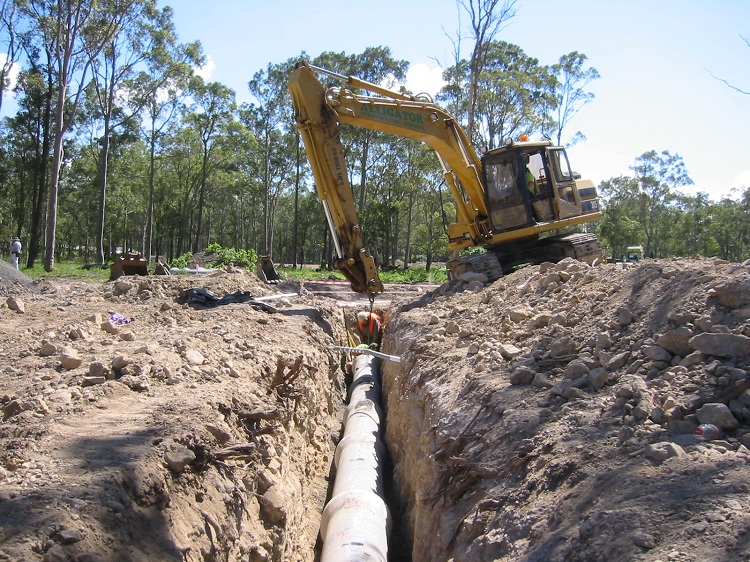
When designing and installing the system, environmental factors must be taken into account - soil type, climate features, groundwater level
According to SNiP 2.04.03–85, external sewage networks are designed to determine the environmental features of the area. Consider the main environmental factors that affect the design of outdoor sewers:
- Soil features. Before designing the sewage system, it is necessary to determine the composition and characteristics of the soil within which the installation of communication will be performed. Depending on the composition of the soil, they determine in what way it is better to mount the sewage system, especially for unstable soil.
Important! In addition, it is necessary to calculate the number of climbs and slopes on the path of the future design.
- Ground water level. A very important factor, which includes the location of groundwater and their quantity, is taken into account when installing water supply and sewage systems.
- Climatic conditions. The climate in a particular region determines the choice of thermal insulation material for communication.
In addition, it is worth identifying the following factors:
- The volume of drains. The volume of wastewater is calculated based on the number of people operating the sewage system, the presence in the settlement of industrial enterprises and any other organizations connected to the sewer system.
- The second important point is the determination of the distance from communication to residential buildings, industries and any other buildings. The location of pumping stations and treatment facilities also needs such a calculation.
It is also worth noting that the crossings of pipelines for water supply and sewage through water barriers, ravines and road surfaces must comply with the rules of SNiP. As a rule, the transition method for water supply and sewage systems is established by the project.
Materials used for the installation of outdoor sewer networks
In addition to all of the above factors, a very important point is the selection of the necessary materials for arranging the sewer network and water supply network. Wastewater is the medium that is transported through sewer pipes. Such a working environment is characterized by aggressive properties, therefore, for the arrangement of communication, it is necessary to select materials that have the appropriate characteristics for working in such conditions.
Consider the main materials that are used for the installation of external water supply and sewage networks:
- polyvinyl chloride (PVC);
- polypropylene (PP);
- polyethylene (PE);
- steel;
- cast iron;
Today, metal sewer pipes are being actively replaced by polymer parts from the construction market. For outdoor installation, the plastic version of the water supply system is especially popular. This is due to the fact that the outdoor installation of metal pipes is much more labor intensive.
Polyethylene pipes are also quite popular in the installation of sewer systems, however, the open installation of such pipes is not the best option. This is due to the fact that they have poor resistance to ultraviolet rays. On the street, they quickly lose their properties and are destroyed, so their outdoor installation is allowed only if a protective casing is used. As such, the old steel pipeline can act.
The most profitable and reliable option of all is the use of pipes made of polyvinyl chloride. They are notable for their low cost, good strength characteristics, and resistance to ultraviolet radiation. Their installation is faster than the wiring of metal analogues. PVC pipes for external sewage differ in diameter and length, and also have different wall thicknesses. The diameter and length of PVC pipes for external sewage are presented in table No. 1.
Table 1
| Mm | Length m |
| 500 | 3,0–6,16 |
| 400 | 1,2–6,15 |
| 315 | 1,2–6,14 |
| 250 | 1,2–6,13 |
| 200 | 1,2–6,09 |
| 160 | 0,58–6,08 |
Sewer pipes made of polyvinyl chloride are used to equip internal and external sewer networks and structures.
PVC pipe can be:
- pressure head;
- pressureless.
The surface of such pipes, as a rule, is smooth, however, corrugated sewer pipes made of polyvinyl chloride are also found.
PVC non-pressure pipes are used for the installation of external sewer communications that transport liquid at a certain slope. The speed of movement of the working medium in such pipelines does not exceed 8 m / s. From pressure pipes, structures are mounted that discharge wastewater using pumps. The pressure in the pressure sewer made of polyvinyl chloride, installed by an external method, can reach 10 atmospheres or more.
Polyvinyl chloride corrugated pipes have the main advantage that they can be installed in problem areas. In addition, for their installation does not need to have special equipment. Corrugated PVC pipes are used both in pressure and in non-pressure communications. The dependence of the wall thickness of the PVC pipe on the diameter is shown in table No. 2.
table 2
| Mm | Wall thickness mm | ||
| Lungs (SN2) | Medium (SN4) | Heavy (SN8) | |
| 500 | 9,8 | 12,3 | 15,3 |
| 400 | 7,7 | 9,8 | 12,3 |
| 315 | 6,2 | 7,7 | 9,7 |
| 250 | 4,9 | 6,2 | 7,7 |
| 200 | 3,9 | 4,9 | 6,2 |
| 160 | 3,2 | 4,0 | 4,9 |
| 110 | – | 2,7 | 3,4 |
In some cases, materials such as reinforced concrete and asbestos cement are used. They are used when the organization of pipes with a very large diameter is necessary. Such materials do not differ in high strength, therefore, non-pressure sewers are installed from them, which discharge sewage in a natural way.
Features of installing an external sewage system
Compliance with building codes allows us not only to correctly install the external sewage system, but also to extend the operational life of all elements included in such a system. It is very important to give the right slope of communication. This will allow the discharge of wastewater to the treatment plant in a natural way. According to SNiP, the pipeline should be mounted obliquely in the direction of the well. The inclination angle itself, as a rule, is determined by the diameter of the mounted communication and can be 2-3 cm for each meter of the structure.
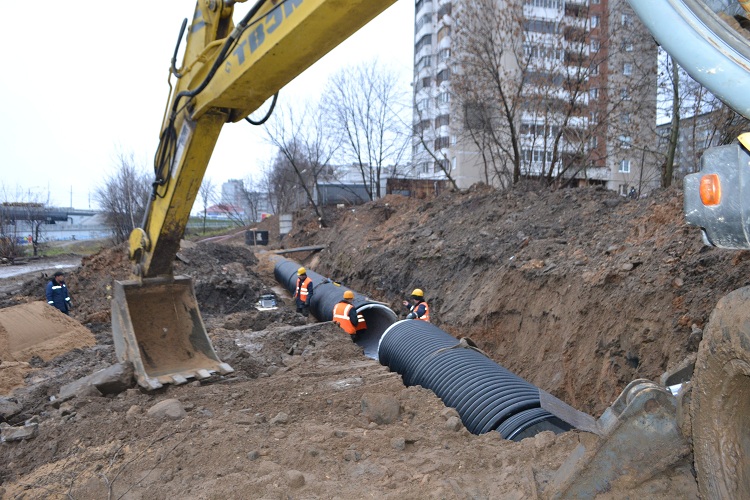
It is very important to correctly calculate the diameter of the pipes that will be installed to serve the area or home
Helpful information! If you make the angle of inclination larger, this will contribute to the clogging of the pipeline, since solid particles will be trapped in the pipe.
In accordance with the joint venture of external networks, there are certain diameter standards for sewers that serve a different number of houses. When draining sewage from several private houses, sewer pipes must be at least 200 mm in diameter, and when draining sewage from one house - 100–110 mm. Pipes that are mounted between the wells should be located exactly, without any slopes. In addition, it is worth noting that during the design, it is necessary to draw up a plan for the movement of communication, applying to it both the pipeline and all nearby buildings. This will eliminate possible troubles during the installation of this system.
First of all, it is necessary to determine the place in which the prefab well will be installed. When calculating the place, you must pay attention to the type of catchment. It can be an ordinary well or septic tank. A septic tank differs from an ordinary well in that it can not only concentrate effluents in one place, but also dispose of them. It is worth remembering that the most suitable option for the location of the catchment is the lowest place on the site.
If the catchment is to be cleaned up using sewage equipment, then it is advisable to choose a place for the installation, which will be located near the roadway. When installing external sewage communication in places of depth differences, as well as during bends, it is mandatory to equip observation wells. In addition, inspection wells are mounted if the length of the straight section of the pipeline is more than 25 m. Such a well is intermediate.
Communication throughout the entire length should consist of pipes identical in material. This is due to the fact that different materials have different indicators of thermal expansion, so combinations of materials contribute to the destruction of the highway.
